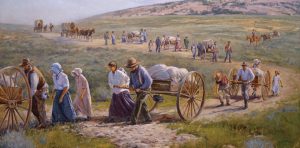
Utah had been around for about fifty years prior to President Cleveland granting the statehood on this day (January 4th) 1896.
Mormon settlers had begun to enter the Salt Lake Valley while the land was still owned by Mexico in 1847. Fortunately for them, the Americans won the Mexican war the following year while President Polk was in office. In the treaty of Guadalupe Hidalgo, Mexico had to give what is now the American West to the United States.
The Mormons immediately wanted to form their own state and name it Deseret-a word from the Book of Mormon meaning honeybee or referring to the ‘bee crown’ in ancient Egypt. The terrain it would encompass included parts of New Mexico, Colorado, Wyoming, Arizona, California, and Nevada. The members of the church elected all LDS leaders and voted in Brigham Young to be the official governor of Deseret.
Congress had other ideas.
During this time, the Civil War was still headline news and slavery was a hot topic. States were individually voting to keep or abolish it. The leaders in Washington knew creating such a humongous state wouldn’t be in the best interest of the country. It would give too much power to the west. Congress formed the Utah and New Mexico territories under the Compromise of 1850 giving them each their own control and vote regarding slavery. The Utah territory (which most still called Deseret) was cut substantially in size but was still bigger than modern Utah, including the majority of Nevada and a bit of Colorado and Wyoming.
President Fillmore appointed Brigham Young as the official territorial governor and (much to the local’s dismay) added some non-Mormon leaders to the administration as well. Somewhere along the line in 1852 some of the leaders made a public announcement that many of the Mormon families engaged in a plural marriage, or polygamy. Many politicians in the east called polygamy ‘the twin to slavery.’ They were denied statehood based on that revelation.
Another decade passed and Deseret was still not a state. While Abraham Lincoln was president an act called the Morrill Act was passed giving land rights to several states and territories. During that same year, the Morrill Anti-bigamy act was passed. This act limited church and non-profit ownership. There were no federal funds allocated for the enforcement of this act leaving Utahns to govern their own marital status.
It was documented that President Lincoln compared the LDS church to a log he had encountered as a farmer. He said, “[It] was too hard to split, too wet to burn, too heavy to move, so we plow around it. That’s what I intend to do to the Mormons.” The messenger was instructed to return and give the message ‘If he will let me alone, I will let him alone,’ regarding Brigham Young and his territory. Again, Utah was denied statehood.
When President Buchanan came on the scene he fired Brigham Young as the governor and sent Alfred Cumming to be the new man in charge as well as a twenty-five-hundred-man army to make sure there were no problems. During this same time, 1864, Nevada became a state and a large chunk of Deseret was granted to them. Again, they applied for statehood, again they were denied.
Later, in 1872 and again in 1882, Deseret applied for statehood and was rejected both times. In 1876 Colorado was granted statehood and took another small slice of Deseret. By this time the Utah territory had made polygamy a misdemeanor instead of a felony, a huge relief for those still practicing plural marriage. In 1881 the People’s party was dismantled and the citizens were forced to follow suit of the rest of the country and join the Republican or Democratic party. There were over a thousand convictions of unlawful cohabitation between the years 1884 and 1893. (One of which, I believe, was my great-great grandfather… at least so the story goes.)
1890, Wyoming was granted statehood and took another chunk of Deseret for itself, creating the unique shape and boarders of modern Utah.
Congress passed the Enabling Act in 1894 to set many areas on the path to statehood, however; polygamy was banned across the board. It took two more years for Utah to finally reach their goal of statehood. By that time, the government had a mix of Mormon and non-LDS affiliates and Utah was voted the named opposed to Deseret.
After forty years of being denied by Congress and losing more than half of their original acreage, it seemed a good exchange for them to officially give up polygamy to become the forty-fifth state.

Leave a Reply